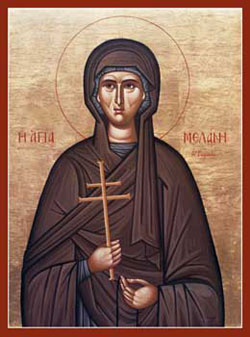
Feastday: December 31
Birth: 383
Death: 439
St. Melania whose feast day is December 31. Melania was born to wealthy Christians, Publicola, a Roman senator, and Albina. At fourteen, she was given in marriage to Valerius Pinianus. When two of her children died soon after childbirth, her husband agreed to lead a life of continency and religious dedication.
Inheriting her father's vast wealth, Melania endowed monasteries in Egypt, Syria, and Palestine and aided churches and monasteries in Europe. To escape the barbarian invasions, she fled with her mother and husband to Tagaste in Numidia in the year 410.
In 417, all three made a pilgrimage to the Holy Land and settled at Jerusalem, where Melania became a friend of St. Jerome. After the death of her mother in 431 and her husband in 432, Melania attracted disciples to her solitary way of life and built a convent, for which she was Abbess until her death on December 31, 439.
The life of St. Melania reminds us of the fleeting character of earthly wealth. We should strive to emulate her use of wealth as well as talents to further the cause of Christ.
Saint Melania the Younger (born in Rome c. 383, died in Jerusalem on 31 December 439) is a Christian saint and Desert Mother who lived during the reign of Emperor Honorius, son of Theodosius I. She is the paternal granddaughter of Melania the Elder.
The Feast of Melania the Younger is held on 31 December (the Julian calendar's 31 December falls on 13 January on the Gregorian calendar). In Ukraine, by Orthodox Christians, Malanka ("Melania's Day") is celebrated on 13 January, and on 31 December by other Christians.
Life
Rome
Melania was born to Valerius Publicola – the son of Melania the Elder – and his wife Albina. She married her paternal cousin, Valerius Pinianus, at the age of fourteen. After the early deaths of two children, she and her husband embraced Christian asceticism and maintained a celibate life thereafter. Upon inheriting her parents' wealth, she donated it to ecclesiastical institutions and to the poor through anonymous intermediaries.
Sicily and Africa
Melania and Pinianus left Rome in 408, living a monastic life near Messina (Sicily) for two years. In 410, they travelled to Africa, where they befriended Augustine of Hippo and devoted themselves to a life of piety and charitable works. Together they founded a convent of which Melania became Mother Superior, and cloister of which Pinianus took charge.
Palestine
In 417, they traveled to Palestine by way of Alexandria, living in a hermitage near the Mount of Olives, where Melania founded a second convent. After the death of Pinianus c. 420, Melania built a cloister for men, and a church, where she spent the remainder of her life.
Properties
Melania had "vast domains in Sicily" and also held land in Britain. She also owned grand estates in Iberia, Africa, Numidia, Mauretania and Italy. Gerontius describes one of her estates as follows: "On one side lay the sea and on the other some woodland containing a variety of animals and game, so that when she was bathing in the pool she could see ships passing by and game animals in the woods... the property [also] included sixty large houses, each of them with four hundred agricultural slaves."
Legacy
Today, the town of Sainte-Mélanie in Canada is named in her honour.
Hagiography
An account of Melania's pursuit of the ascetic life survives in a hagiography or biography, written by Gerontius c. 452.
Further, there is an account of her life by Palladius (d. A.D. 431) as well.
Ancestry
| Ancestors of Melania the Younger | |||||||||||||||||||||||||||||||||||||||||||||||||||||||||||||||||||||||||||||||||||||||||||||||||||||||||||||||||||||||||||||||||||||||||||||||||||||||||||||||||||||||||||||||||||||||||||||||||||||||||||||||||||||||||||||||||||||||||||||||||||||||||||||||||||||||||||||||||||||||||||||||||||||||||||||||||||||||||||||||||||||||||||||||||||||||||||||||||||||||||||||||||||||||||||||||||||||||||||||||||||||||||||||||||||||||||||||||||||||||||||||||||||||||||||||||||||||||||||||||||||||||||||||||||||||||||||||||||||||||||||||||||||||||||||||
|---|---|---|---|---|---|---|---|---|---|---|---|---|---|---|---|---|---|---|---|---|---|---|---|---|---|---|---|---|---|---|---|---|---|---|---|---|---|---|---|---|---|---|---|---|---|---|---|---|---|---|---|---|---|---|---|---|---|---|---|---|---|---|---|---|---|---|---|---|---|---|---|---|---|---|---|---|---|---|---|---|---|---|---|---|---|---|---|---|---|---|---|---|---|---|---|---|---|---|---|---|---|---|---|---|---|---|---|---|---|---|---|---|---|---|---|---|---|---|---|---|---|---|---|---|---|---|---|---|---|---|---|---|---|---|---|---|---|---|---|---|---|---|---|---|---|---|---|---|---|---|---|---|---|---|---|---|---|---|---|---|---|---|---|---|---|---|---|---|---|---|---|---|---|---|---|---|---|---|---|---|---|---|---|---|---|---|---|---|---|---|---|---|---|---|---|---|---|---|---|---|---|---|---|---|---|---|---|---|---|---|---|---|---|---|---|---|---|---|---|---|---|---|---|---|---|---|---|---|---|---|---|---|---|---|---|---|---|---|---|---|---|---|---|---|---|---|---|---|---|---|---|---|---|---|---|---|---|---|---|---|---|---|---|---|---|---|---|---|---|---|---|---|---|---|---|---|---|---|---|---|---|---|---|---|---|---|---|---|---|---|---|---|---|---|---|---|---|---|---|---|---|---|---|---|---|---|---|---|---|---|---|---|---|---|---|---|---|---|---|---|---|---|---|---|---|---|---|---|---|---|---|---|---|---|---|---|---|---|---|---|---|---|---|---|---|---|---|---|---|---|---|---|---|---|---|---|---|---|---|---|---|---|---|---|---|---|---|---|---|---|---|---|---|---|---|---|---|---|---|---|---|---|---|---|---|---|---|---|---|---|---|---|---|---|---|---|---|---|---|---|---|---|---|---|---|---|---|---|---|---|---|---|---|---|---|---|---|---|---|---|---|---|---|---|---|---|---|---|---|---|---|---|---|---|---|---|---|---|---|---|---|---|---|---|---|---|---|---|---|---|---|---|---|---|---|---|---|---|---|---|---|---|---|---|---|---|---|---|---|---|---|---|---|---|---|---|---|---|---|---|---|---|---|---|---|---|---|---|---|---|---|---|---|---|---|---|---|---|---|---|---|---|---|---|---|---|---|---|---|---|---|---|---|---|---|---|---|---|---|---|---|---|---|---|---|---|---|---|---|---|---|---|---|---|---|---|---|---|---|---|---|
| |||||||||||||||||||||||||||||||||||||||||||||||||||||||||||||||||||||||||||||||||||||||||||||||||||||||||||||||||||||||||||||||||||||||||||||||||||||||||||||||||||||||||||||||||||||||||||||||||||||||||||||||||||||||||||||||||||||||||||||||||||||||||||||||||||||||||||||||||||||||||||||||||||||||||||||||||||||||||||||||||||||||||||||||||||||||||||||||||||||||||||||||||||||||||||||||||||||||||||||||||||||||||||||||||||||||||||||||||||||||||||||||||||||||||||||||||||||||||||||||||||||||||||||||||||||||||||||||||||||||||||||||||||||||||||||





